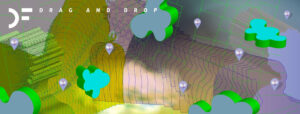Despite their omnipresence in everyday life, our image of virtuality and digitality is strongly influenced by science fiction scenarios. It is up to us to decide which ethical and moral values we want to set in relation to the challenges of the digital age in order to define the future of the relationship between man and machine and its hybrid forms.
With the dialog fields, we are opening up a public artistic discourse space for these questions. On the topic of digitality in urban space, we are inviting two artists to the Chemnitz Sonnenberg in three stages at the same time. They will translate their visions and fantasies on the topic into interventions in the urban space and counter (apparent) science fiction scenarios in everyday life with real spaces for experience and experimentation.
“Drag and drop” is the most intuitive form of virtual interaction. It changes, shifts, arranges, edits, copies and thus opens up new worlds and possibilities.
Under this title, we therefore pose the question in the (urban) space as to what kind of digitality enriches public space and which should be critically examined and questioned. From augmented reality to holography, projection mapping and robotics – we are asking artists from various disciplines to realize their visions and versions of digital participation in the Sonnenberg district and to transfer the principle of “drag and drop” into analogue space.

